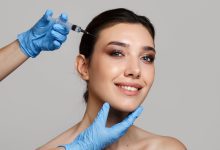Aloe Isn’t Just For Sunburn—3 Surprising Reasons You Should Use It 365 Days a Year

Aloe is synonymous with sunburn. In fact, that’s pretty much the only thing it’s known for—soothing red, sun-crisped skin. It makes sense, seeing as most of us were introduced to it at a young age, either by seeing the bright blue-green gel bottles line the drugstore shelves or by sullenly rubbing it on ourselves after a hot beach day. Either way, unless you’re dealing with a sunburn, it’s likely rare that you ever think about it at all.
Here’s the thing, though. Aloe is beneficial to the skin in ways that are beyond simple sunburn-soothing. And whether you realize it or not, it’s one of the main ingredients in many of your favorite skincare products. Keep scrolling to learn why dermatologists say aloe is a must-have skincare ingredient 365 days a year.

Aloe for Soothing Skin
Blair Murphy-Rose, MD, FAAD is a leading board-certified cosmetic, medical, and surgical dermatologist specializing in facial rejuvenation at the Laser & Skin Surgery Center of New York and a Clinical Instructor of Dermatology at Weill Cornell Medical College. She’s also the founder of Skincare Junkie. She says aloe is a succulent that has been used for centuries as a skin remedy. “The skin benefits from topical application of aloe include enhanced wound healing, reduced inflammation (decreased redness and swelling), and some pain control,” she says.
That explains why it’s so often used for sunburn. “Aloe is particularly well-suited for burns and after-sun care,” she says. “Aloe contains antioxidant enzymatic systems like glutathione peroxidase and superoxide dismutase that can neutralize the effect of free radicals. Aloe naturally contains anti-microbial and anti-inflammatory properties, both of which may gently treat or prevent skin infections in compromised skin. Anthraquinones in aloe are thought to have anti-viral and anti-fungal effects.” To put it simply, aloe is an antioxidant, anti-inflammatory, anti-microbial, anti-viral, and anti-fungal powerhouse.
Little do most people know, aloe can be used post-skin treatment to soothe the effects of lasers, peels, and other in-office procedures. Next time you’re going in for a specific treatment, ask your provider how aloe could help soothe and heal your skin after the fact.
Aloe for Acne and Anti-Aging
As if that’s not enough. Murphy-Rose says it may even prevent acne and stimulate collagen production. That means it can lead to clearer, more youthful-looking skin. Who knew? I think it’s safe to say that aloe is incredibly underrated.

Aloe For Hair & Scalp
Brendan Camp, MD, FAAD, a dermatologist at MDCS Dermatology says aloe can even be used in the hair and scalp. “Aloe can be used as a scalp treatment to address dryness and flaking,” he says, and even “a hair mask to fortify damaged hair.” That’s because of its high water content and aforementioned antioxidant, anti-inflammatory, and anti-microbial benefits.

Best Skin Types for Aloe
“It is usually well tolerated and gentle for all skin types including very sensitive skin,” Murphy-Rose says. Still, she warns that “It is possible to have a true allergy to aloe. If you develop any rash or discomfort including pain, itch, or burning within a few days of using aloe, you may have an allergy to aloe and should avoid future exposures.”
Camp echoes this, saying that while most skin types can use aloe, it’s better to be safe than sorry and perform a patch test before using it. The only other thing to keep in mind is that “not all aloe vera products are made the same.” Camp says it’s important to read an aloe product’s ingredient list before buying it. “Some contain many other ingredients and are not pure aloe.”
Aloe Skincare Products
Source: WhoWhatWear
Related Posts
- 5 foods you must have if want Korean Glass Skin
- I Asked the Coolest People I Know: What Makes an It-Girl Lip Balm?
- 7 hairstyles for women popular in 2025 weddings
- 12 Coconut Perfumes That Smell Like an Expensive Vacation (and Not Sunscreen)
- The 6 Hats Everyone Will Be Wearing Instead of Bucket Hats This Summer





